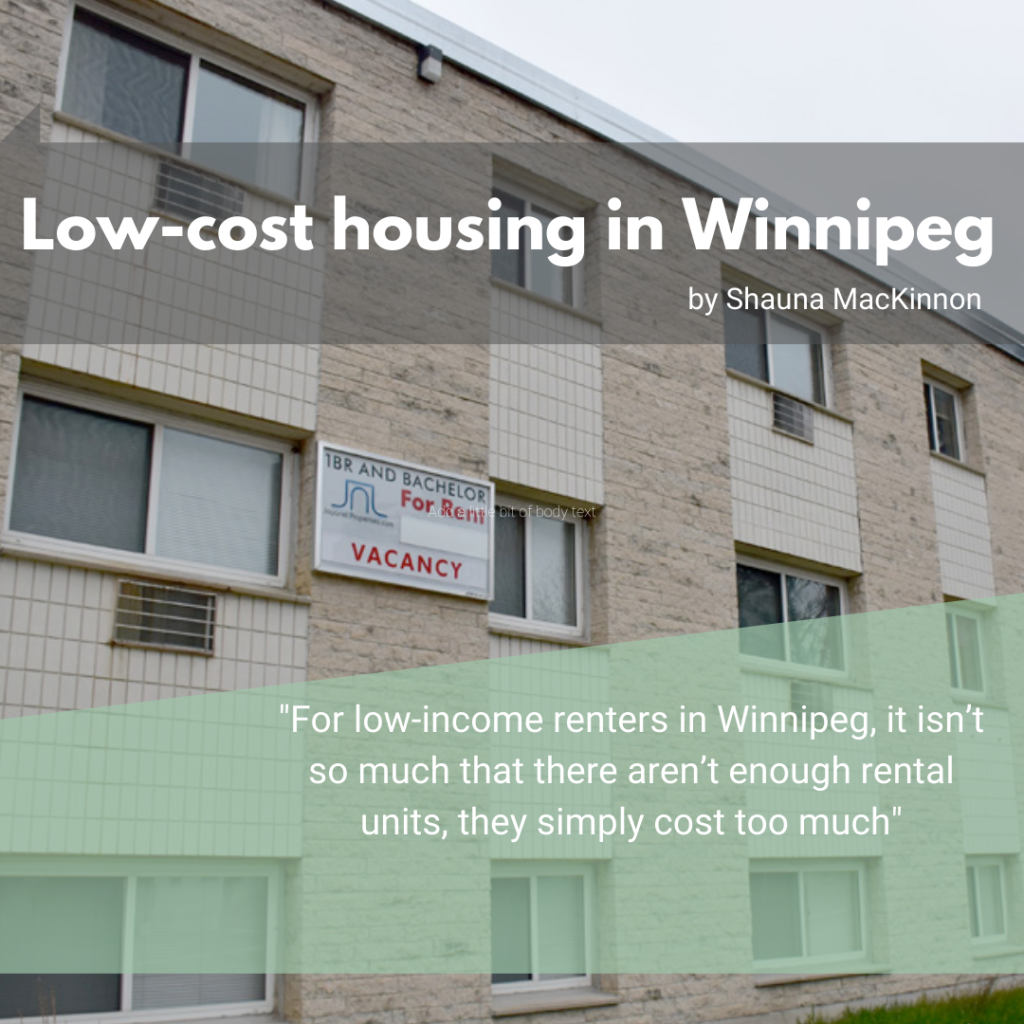
Previously published in the Winnipeg Free Press April 27, 2022
By Shauna MacKinnon
There continues to be a severe shortage of low-cost rental supply in Winnipeg, at the same time that rental vacancies are generally on the rise. This problem is not unique to Winnipeg. It is a problem across Canada, and governments are doing a poor job solving it.
The most recent Canada Mortgage and Housing Corporation (CMHC) rental report confirms that for the lowest income quintile earners— those earning less than $25K per year— options are scarce. An affordable monthly rent for this group would be less than $625 per year. Units renting at this rate represented less than 3% of the total rental universe in 2021 while this income group represents roughly 20% of all renter households.
While low-income rental supply is near impossible to find, there is currently a 5% vacancy rate for an average-cost 2-bedroom purpose-built rental. This is the highest rate since 1997 and considerably higher than the 3% considered to be a healthy rate. The high vacancy rate is largely due to an increase in high-cost purpose-built rental apartments that far exceeds the demand. Units new to the market have average rents upwards of $1541 per month. And the supply continues to grow while units sit vacant. CMHC reports a 30% year-over-year increase in the number of apartment units under construction in the Winnipeg market, few if any will be affordable for low-income households.
The vacancies in high-end units and the shortage of low-cost units tells us that there is a disconnect between the kinds of rental units being provided (supply) and what is needed (demand).
A major cause of this disconnect was outlined in a 2018 report by the United Nations Special Rapporteur on Housing. Leilani Farha described the growing inequities caused by the financialization of rental housing – the unprecedented dominance of financial markets and corporations in the housing sector. The treatment of housing as a means of accumulating wealth has superseded the foundational importance of housing as a basic human right. In a nutshell – investors don’t care about housing at all. They are simply looking to maximize a return on their investments.
The ascendancy of real estate investment trusts (REIT) and the financialization of rental housing is a serious problem in big cities, but smaller markets like Winnipeg are beginning to see this too. REITs appeal to Investors for a number of reasons. For some, they are seen as a long-term stable investment opportunity. One financial investment blogger described residential REITs as “not sexy, but they represent vital property types society literally can’t function without.” According to CBC’s Fifth Estate, the four largest REITs in Canada disbursed more than $2 billion in profits to their investors between 2015 and 2020. While real estate investment has become a lucrative field, it comes with a heavy social and economic price.
Government Role
Since the 1980s, governments have relied almost entirely on the private sector to meet housing needs and have enabled the financialization of rental housing. The problems caused by this approach have become abundantly clear, yet governments have yet to take the problem seriously.
In the 2022 budget speech, Minister Freeland spoke about Canada’s housing problem, but she emphasized a problem of supply— “we need more homes fast”. For low-income renters in Winnipeg, it isn’t so much that there aren’t enough rental units, they simply cost too much. There is a nod to non-market housing in the 2022 federal budget, but the primary focus is still on incentives to build market housing, as well as a bit of help for first time homebuyers. The commitments are said to build on the 2017 National Housing Strategy and the National Housing Strategy Act which became law in 2019. Neither have had much impact despite claiming to “focus on improving housing outcomes for persons in greatest need.” The National Housing Research Working Group recently described the failure of the NHS to meet the needs of low-income renters. The Group estimates a mere 3% of the Rental Construction Financing Initiative (RCF) has created units that are “suitable to and affordable to low-income tenants”.
The Province of Manitoba has also failed miserably. In order to access funding through the National Housing Strategy, Manitoba released a 3-year action plan in 2019 but it steered clear of any commitments to what we know is needed most—social housing. The recently released Manitoba budget does not invest in new social housing and scales back its commitment to maintaining the existing supply. It continues to defer to the private sector to meet all housing need. Ironically, the sector itself says what social housing advocates have been saying for years. In a CBC interview, the CEO of REALPAC, the association that represents many of Canada’s largest real estate companies, made clear that “…deeply affordable housing is a public good, and the private sector is not primarily in the business of providing a public good.”
The market has clearly failed to respond to the demand for low-cost rental housing. Replenishing the supply of housing for the public good will require governments at all levels to use the tools each has available to stop the bleeding caused by the financialization of housing. This will include a full range of taxation and regulatory measures, an end to subsidies to private sector rental housing developers and large-scale investment in the development and maintenance of publicly owned rental housing.
Shauna MacKinnon is Professor and Chair of the University of Winnipeg, Department of Urban and Inner-City Studies, a long- time member of the Manitoba Right to Housing Coalition and a Canadian Centre for Policy Alternatives – Manitoba Research Associate.


